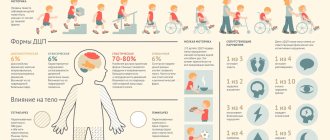Such a complicated dream
If you think that you fall asleep and sleep well all night, then you are very mistaken. In fact, sleep can be different, and it consists of several phases. Scientists have long tried to figure out their sequence and duration, and one of the researchers identified the following stages:
- Falling asleep. At this stage, some hallucinations or images may occur, which are usually associated with events experienced during the day. It seems to a person as if he is “falling” into sleep, immersed in it.
- Next comes light sleep, which can last from ten to thirty minutes. At this stage, a person is quite easy to wake up, because his brain, in fact, has not yet switched from wakefulness mode completely and completely.
- The first stage of slow-wave sleep.
- Second stage of slow-wave sleep. This phase is considered the deepest; a person is completely unaware of his actions and is not aware of what is happening. And therefore, it is during this period that some people begin to talk or show physical activity: get out of bed or even move.
- Next comes the stage of rapid eye movement sleep, which some scientists call “REM.” At this stage, the muscles completely relax, the body immobilizes, only periodic involuntary contractions and shudders are possible. At this time, the sleeper sees very vivid and sometimes incredibly realistic dreams. Moreover, if you wake him up at such moments, he will clearly remember everything and tell the dream in great detail. But someone who wakes up at the stage of slow-wave sleep will remember almost nothing about his nightly adventures.
From the moment you fall asleep to the start of REM sleep, about 50-70 minutes usually pass, and then this phase repeats approximately every hour and a half.
Its duration in the first half of the night is usually no more than ten minutes, but then it gradually increases (the duration of slow-wave sleep is correspondingly reduced) and reaches 20-30 minutes, and by the morning it can reach up to an hour. So the longest and most vivid dreams most often occur just before waking up.
REM sleep occupies approximately a fifth of the entire sleep period, which means that we can conclude that a person relaxes and sleeps fully for only about six hours per night (with eight hours of sleep).
How does the biological clock work and why do we need dreams?
The Institute of Plant and Animal Ecology of the Ural Branch of the Russian Academy of Sciences is hidden in the depths of the Botanical Garden, at the South Tram Station. Last weekend, a large conference of young scientists dedicated to ecology ended there. IMC author Elena Babushkina attended one of the lectures and recorded a summary of the speech of the famous popular scientist, Doctor of Biological Sciences, somnologist, participant in the PostScience project Vladimir Kovalzon
. For half a century he has been researching the physiology of sleep, conducting experiments, translating books by foreign somnologists, and publishing his own articles and essays on sleep.
How sleep works
During the night, a person goes through three to four sleep cycles - each lasting about 90 minutes.
The first part of the night we sleep in slow-wave sleep without dreams, the second in rapid sleep, or paradoxical sleep. This period is characterized by complete muscle relaxation and extraordinary brain activity.
The mechanisms of wakefulness, slow-wave sleep, REM sleep and the biological clock mechanism indirectly related to them are isolated in their functionality. Each has its own evolutionary genetic history, anatomy, physiology and biochemistry. The blocks interact with each other, but are isolated. Thanks to this, we can work the night shift and sleep during the day.
During the period of slow sleep, motor skills are activated, and it is in this cycle that sleepwalking occurs.
In young children, parasomnia occurs at the end of each sleep cycle: the child may sit up in bed, start talking, and move. And that's okay. Persisting into adulthood, sleepwalking becomes a pathology.
We dream during REM sleep.
Usually, only the eye muscles move, while the rest are at rest. However, sometimes the flow of impulses from systems active in the paradoxical phase is so powerful that it breaks through the strongest tonic inhibition aimed at the spinal cord. As a result, cats' whiskers may twitch, and humans may have limbs that tremble. The occurrence of such processes (somnologists call them phasic) helps to diagnose various diseases.
Limb cramps, screams in sleep and other inappropriate movements may indicate approaching Parkinson's disease.
This is an important early predictor for medicine, allowing the onset of the disease to be delayed by ten to twenty years.
Living beings implement sleep cycles in different ways.
Large predators that are not afraid of anyone, or burrowing animals sleep peacefully. They have a lot of REM sleep, which has a maximum awakening threshold. Try to wake a person when his eyelids are twitching - you are unlikely to succeed.
On the other hand, ungulates do not have this opportunity. The horse has only half an hour of REM sleep, which he realizes at once. She experiences slow-wave sleep while standing, and for fast sleep she lies down on her croup and gives out the entire daily quota of necessary fast sleep. In a herd, sleeping horses are placed in the center, and guards stand at the edges to protect the sleeping horses from predators.
Eared seals, fur seals, sea lions and sea lions sleep in an amazing way. They spend part of their lives in rookeries where they breed, and part of their lives at sea, chasing schools of fish. On land, all these animals sleep, like us, with both hemispheres at the same time, and have a pronounced REM sleep phase with twitching of their whiskers and fins. However, on the water, the hemispheres are awake alternately, controlling the movements of the fins that paddle during sleep and the eyes turned to the surface. REM sleep in a fur seal is reduced to one-second fragments, while in a dolphin that lives in water all the time, it is simply absent.
There are no documented examples in science of a person lacking complete sleep.
Somnologist Michel Jouvet describes only one pathological case when a person who contracted viral chorea in Africa came to him for treatment. In addition to high fever and other pathologies, during the six months of recording the encephalogram, the patient did not record any sleep. Unfortunately, it was not possible to save him.
Why are we sleeping
Evolution has created a dreamless state of slow-wave sleep,
to implement a whole list of functions that, for some paradoxical reason, cannot be activated in an alert state.
There is a process that is jokingly called "plunging".
The myriad of ion channels located in nerve cells become clogged during prolonged wakefulness. When the cerebral cortex moves from a state of wakefulness to a state of slow-wave sleep, electrical activity changes, and powerful jumps in potentials produce pumping of ion channels. On an electrical level, it looks like we are unclogging a sink.
During sleep, the brain performs a drainage function, getting rid of ugly proteins.
The macromolecule synthesis hypothesis is based on the fact that for some reason some macromolecules cannot be synthesized during an alert state—especially molecules associated with cholesterol metabolism. At the level of our body, the inactivation of ugly proteins that accumulate with age is solved with the help of the lymphatic system. It transports them to the kidneys and liver, where they are destroyed. The brain is deprived of this system, and unnecessary molecules cannot penetrate the venous capillaries.
In 2013, a group of Danish researchers in the United States proved using mice that during slow-wave sleep, special tubules open in the brain through which ugly proteins are effectively removed. Violation of this removal leads to the formation of plaques, which provoke the development of senile diseases - Alzheimer's and Parkinson's diseases.
According to one hypothesis, during sleep the brain optimizes the control of internal organs.
We do not have a second brain to deal with internal affairs, so in the waking state the brain is busy analyzing information coming from the outside. He has no time for the intestines, heart, liver and kidneys. But during the period of slow sleep, the cerebral cortex switches and begins to work with information coming from internal organs. The same neurons that react to visual images in wakefulness, in sleep react to and control impulses coming, for example, from the intestines.
One of the most important mysteries of somnology is the place where the memory of a dream is stored.
If you don't get enough sleep, the memory of it will be stored in dynamic memory for many months until the need is satisfied. Only an electric shock can erase information about lack of sleep. And even in this case, you will definitely fall into a compensatory sleep at the first opportunity, when you find yourself outside the pressure of society.
The main task of a modern person is to get enough sleep.
If in the 19th century a person fell asleep on horseback or in a cart, the horse either continued moving, knowing the way, or stopped. You know what happens when a driver falls asleep for a split second at a speed of 80-100 kilometers per hour. Now all the somnologists in the world are busy solving the problem of lack of sleep, studying spontaneous falling asleep and extreme sleepiness during the day. In Europe there is even a special Wake up bus, a propaganda bus.
Recently, a special law was passed in Europe requiring the monitoring of people with sleep apnea.
This disease is typical for young people engaged in business. They experience constant stress, tend to smoke and drink, do little exercise, and one day begin to snore. During apnea, pulmonary ventilation stops for a short time, which can lead to lack of sleep and impaired blood supply to the brain. Such nights are dangerous because a person thinks he has had enough sleep, but his brain has not actually slept.
If you know a person who matches the description, recommend that he undergo a special examination. Sleep apnea is effectively treated non-drug using a device called CPAP.
How the brain works during sleep and wakefulness
Universities teach that the main system of the brain is its cortex.
However, the cortex needs additional activation: the system that ensures the state of wakefulness is not built into it. You can listen to me, and I can speak to you, thanks to the ascending influences of clusters of nerve cells located throughout the cerebral axis. In turn, the descending influences of these cells ensure the functioning of the spinal cord.
We see what happens when downward activation is interrupted by the example of Stephen Hawking.
He suffers from ALS - amyotrophic lateral sclerosis. His upward activation is completely intact, as demonstrated by his amazing brain, but his downward activation has completely disappeared because the pathways have atrophied.
Interruption of the ascending activating influence on the cortex causes coma.
All our cognitive activity, the ability to think, talk, think and feel is connected with this flow. Without upward influences, the cerebral cortex does not work and is silent. Vision, hearing - everything is actually secondary and works only under conditions of ascending activations.
Sleep cycles predict recovery from coma.
In a superficial coma, a person is unconscious, but his brain maintains sleep cycles. And if a nightly polygraphic recording records both phases of sleep, slow and fast, with proper treatment the patient will come out of a coma with a 100 percent probability.
If the patient does not have REM sleep, but retains deep slow-wave sleep, there remains a 30% chance of emerging from a coma. But if a person has lost both deep phases of sleep, then the chances of salvation are zero. No matter how well his heart beats, this is a living corpse.
The source of the cortex-activating impulse was discovered in the late nineties.
It turned out that in the area of the hypothalamus there are cells that produce the peptide orexin. There are very few of them in our giant one and a half kilogram brain - only 70-80 thousand neurons. But they play a vital role and are the top link above everyone else.
Alternating periods of wakefulness, slow and fast sleep provides melanin-concentrating hormone.
Scientists discovered it in the pituitary gland of salmon, and at first they thought that it was simply a hormone that causes the fish to change color during spawning. A few years later it turned out that this is the most important neurotransmitter in our brain and, naturally, has nothing to do with the color of the scales.
Neurons that produce melanin-concentrating hormone are mixed with neurons that produce orexin. They mutually inhibit each other, ensuring the alternation of wakefulness and sleep cycles.
Evolution has made the process of falling asleep smoother so that the animal survives sleep.
The sleep center is activated gradually so that we can take time, postpone the moment of falling asleep, find a secluded place, bury ourselves, climb a tree, hide in a crevice, nest and, finally, fall asleep. The mechanism operates in the anterior region of the hypothalamus, and many sleep disorders are associated with disturbances in its function. Unfortunately, sleeping pills have a strong destructive effect on it and remain very undesirable.
Sleeping under the influence of alcohol is equivalent to sleeping under the influence of medication.
It does not contain cyclicity and, according to a number of characteristics, is a pathology. If sleeping pills kill the brains of a healthy person, then for a hardened alcoholic this is an adequate treatment method that allows them to restore damaged sleep.
In 2001, another slow-wave sleep center was discovered in the back of the brain, working in parallel with the already known one. Surprisingly, there is no direct connection between these two centers; they work independently. The question of its study is obviously directly related to the onset and cessation of coma.
Why are dreams needed?
During dreaming sleep, the brain is as active as it is during periods of emotional stress.
But this activation is strange and different from emotional activity in the waking state. When we dream, no sensory systems work, because we see them not with our eyes, but with our inner gaze.
At the same time, emotional mechanisms are very strongly activated, and in adults they are more often associated with negative emotional connotations.
Memory mechanisms are also activated, and this process is aimed at retrieving memories. The experience experienced is intricately combined, but does not come back into memory. This is no coincidence and good: dreams, as an evolutionary product, do not exist to be remembered. This is how phenomenally high brain activity occurs during sleep.
Michel Jouvet suggests that such brain activity is needed to transmit genetic information.
When an animal is born, it already knows and can do a lot. Perhaps the memory of behavioral acts, embedded in genes, passes into the memory of the nervous system precisely during REM sleep. And high brain activation is caused by the next rewriting of data, which is stored without access to the outside world.
There are three theories of dreaming: neo-Freudian, Hobbson's three-dimensional model and neurocognitive.
They complement each other, but the most advanced is the neurocognitive theory of Fulks and Domhoff. Scientists believe that dreams are just a consequence of the activation of vision during sleep. The brain cannot help but produce bizarre images, since we are visual animals.
The verbal report of a dream is a psychological phenomenon.
People are more likely to report dreams when under emotional stress. Something worries them so much that it breaks out even in their sleep. Psychologists believe that a normal, healthy person does not feel the need to talk about dreams.
It is strange that we have a ban on the sale of medicines, but the promotion of lucid dreams is not prohibited.
A person learns to program extraordinary adventures in his dreams every night. This leads to the fact that dreams turn into hallucinations, which begin to haunt him even in a waking state. Essentially, it is addiction without drugs. Psychosis occurs and schizophrenia sets in.
How does the biological clock work?
The biological clock is a thing related to the mechanisms of sleep and wakefulness very indirectly.
In 1994, when it seemed that the eyes of mammals had long been studied inside and out, scientists discovered unknown elements there that had nothing to do with vision. They react only to the level of illumination and signal not to the visual system, but to the suprachiasmatic nuclei of the hypothalamus.
The presence of these nuclei is necessary and sufficient for the biological clock to work and control the rhythm of the whole organism.
If a hamster has the suprachiasmatic nuclei removed and given the nuclei of a donor hamster, which has a different rhythm of life - for example, a daily sleep frequency - he will immediately begin to sleep once a day.
The biological clock is a machine hardwired into the brain at the dawn of evolution.
Like an atomic clock, it continues to tick in all living organisms, regardless of social factors and stress. But it is sensitive to light.
For most people, the daily cycle of the biological clock is not 24 hours, but 25.
We fail them every morning when we open the curtains.
Sunlight falls on the eyes and instantly rearranges the functioning of the biological clock. Electric light is ineffective here. This is why it is important to get up after sunrise, or at least with the first rays of the sun, and not in the dark. It's My City works in the interests of the city community. If the presence of such media is important to you, please support us with a donation.
Night activities of our brain
So, what does the brain do while a person sleeps?
- Making decisions. Yes, in a dream, the brain processes all the information received during the day and systematizes it, which helps to quickly find the right decisions after waking up.
- Memorizing and structuring information. Typically, all data received during the day is stored in the so-called short-term memory. And therefore such information is soon forgotten. But in a dream, the brain seems to move it into long-term memory, and therefore we remember a lot of important things, and precisely in a dream. In addition, the brain sorts out all the data, places it on shelves, as if creating an archive. It also connects new information with old information received earlier. So if you don't get enough sleep, your ability to remember can decrease by as much as 40%!
- Getting rid of toxins. Yes, yes, in a dream, the brain seems to tidy up our body, getting rid of everything harmful and unnecessary. And such an amazing function was discovered in the process of observing mice. During sleep, they got rid of substances that could damage nerve cells. This is achieved by increasing the space between cells, so that toxins are easily eliminated.
- Strengthening muscle memory. Since during sleep, data is stored in long-term memory, this allows us not only to remember data, but also to consolidate and bring to automaticity some motor skills, such as dance movements, kicks in sports, driving a car.
- Creative information processing. It has been proven that sleep can stimulate creativity. While a person is sleeping, completely unexpected and interesting associations and connections can form in his brain, which allows him to make creative decisions, look for new alternatives, and also see unusual options for the development of events. And no one would have thought of all this while awake.
Treatment
If the cloudy head appears due to lack of sleep, and the symptom is temporary, then just rest and get enough sleep. If this symptom occurs regularly, measures should be taken to avoid complications.
First of all, you need to see a doctor and find out the cause of the feeling of fog in your head.
If the source is astheno-neurotic syndrome, then it can be cured using psychotherapeutic methods. But first, you should exclude all provoking factors - stress, lack of sleep, excessive physical and mental stress.
If the influence of these factors is not reduced, then psychotherapy and drug treatment will not have the desired effect and will not eliminate unpleasant symptoms.
Medicines are used in severe cases. General restoratives, sleeping pills, antidepressants, antipsychotics and tranquilizers are considered effective.
If you have symptoms of VSD, you should consult a specialist. The therapist deals with this issue. To relieve symptoms, various medications are used - sedatives, sleeping pills, to normalize blood pressure, etc. In addition to drug therapy, it is recommended to adjust your lifestyle:
- engage in light, non-competitive sports;
- learn to eat right;
- travel outside the city more often or simply go outside, taking long walks;
- eliminate stress factors;
- learn to go to bed and wake up at the same time;
Physiotherapeutic procedures, acupuncture, and massage will help get rid of the fog in the head with VSD.
The symptoms of neurosis will be eliminated by drugs that normalize the activity of the autonomic nervous system, as well as drugs with a sedative effect.
In case of poor blood circulation in the brain, accompanied by fog in the head, medications with vasodilating and nootropic effects are prescribed. Pathology at the initial stage can be treated without drugs - with the help of massage and manual therapy.
Treatment of cervical osteochondrosis is aimed at relieving the inflammatory process and eliminating pain. For this purpose, NSAIDs, nerve blockade, and medications that normalize blood circulation are prescribed.
In addition to drug therapy, physiotherapy, physical therapy, massage, and manual therapy are recommended for people with cervical osteochondrosis.
Interesting Facts
Some interesting facts about how the brain works during sleep:
- The saying “The morning is wiser than the evening” actually has scientific justification, since during the night the brain processes, assimilates and systematizes information. Therefore, in the morning we get up with a fresh and sober head, we remember, understand and rethink a lot.
- Mendeleev saw his table of chemical elements in a dream, and this is further proof that the brain really works at night.
- With age, dreams usually become more complex, their plots sometimes reminiscent of intricate stories from films. And this is due to the fact that a person gains experience, and often some images and emotions are blocked by his brain while he is awake, but at night they begin to emerge in the subconscious.
- A dream is a reflection of reality. Moreover, it can be quite strange, since the brain interprets and modifies what is happening in its own way. And sometimes dreams come up with something that happened a few days or even months ago. In addition, analogies can be drawn that are associated not with real attitudes, but with emotions. For example, if you dream that you are taking an exam in a subject that you have not studied, then you have probably experienced an unpleasant situation associated with the inability to achieve something or make the right decision.
- Before an important event, you definitely need to sleep! So studying for exams or conferences at night is not the best option.
- Scientist Calvin Hall conducted research and found that in dreams many people are much more likely to encounter failures and troubles than victories and success. And with age, dreams are filled with negativity and even aggression. That is why only children often have good dreams, and even before adolescence.
Now you know that sleep is not only a pleasant, but also a useful and productive activity.









